Evenflo Child Restraint System LiteMax DLX Owners Manual

Content
Introduction
The Evenflo Child Restraint System LiteMax DLX is a top-tier infant car seat designed for safety and comfort, accommodating infants weighing between 4 to 35 pounds and measuring 17 to 32 inches tall. This rear-facing car seat features a no-rethread harness, multiple recline positions, and a load leg for added stability during travel. With its easy installation and plush fabric, the LiteMax DLX ensures a secure and cozy ride for your little one. The cost of the Evenflo LiteMax DLX is $179.99, making it a valuable investment for parents prioritizing safety.
Replacement Parts
Not available on all models. Styles may vary.
To order replacement parts you can order online at https://www.evenflo.com or contact Evenflo. When you contact us, please have the product model number and date of manufacture (found on the back of the child restraint).
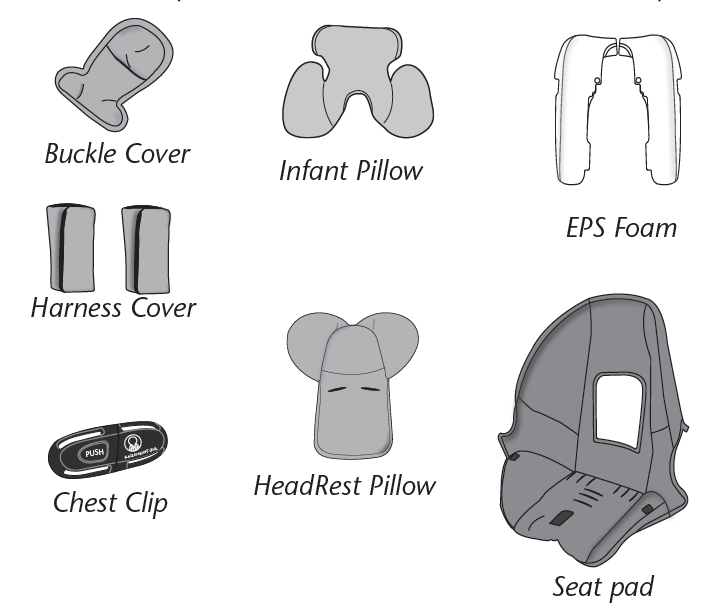
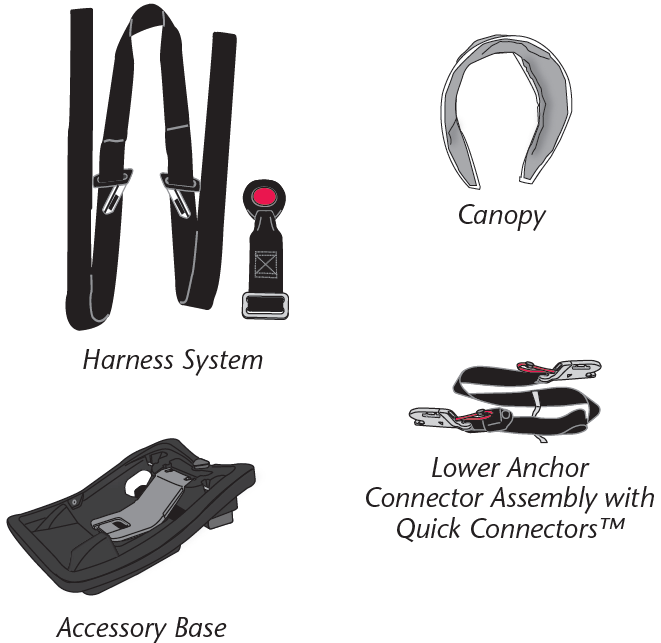
Detailed Specifications
- Weight Range: 4-65 lbs
- Height Range: 17-57 inches
- Rear-Facing Capacity: 4-40 lbs, 17-40 inches
- Forward-Facing Capacity: 22-65 lbs, 28-57 inches
- High-Back Booster Capacity: 40-110 lbs, 43-57 inches
- Materials:** High-quality plastics and fabrics
- Safety Features: Side impact protection, steel frame, and energy-absorbing foam
- Installation Methods: LATCH system, seat belt
- Warranty: 2-year limited warranty
Base Features
- Level Adjustment Knob
(Not available on all models) - Angle Indicator
- Leveling Foot
- LATCH connector
- Vehicle Seat Belt/Lower Anchor Connector Assembly Belt Path
- One Step Lock-Off
- SafeZoneTM Load Leg (Available on all models)
Load Leg adjustment buttons
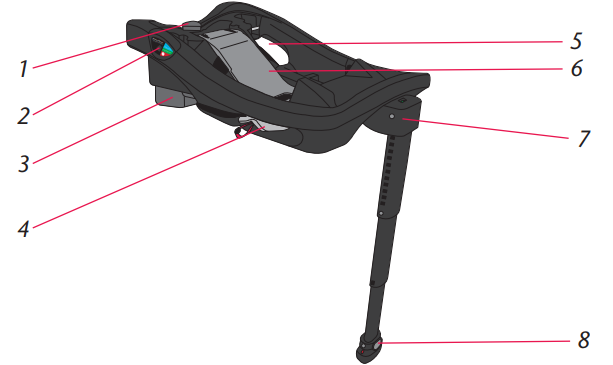
- Load Leg storage
LATCH storage
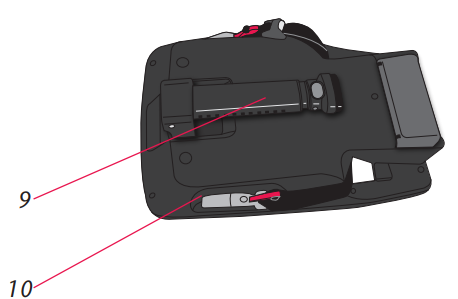
Child Seat Features
- Handle
- Canopy*
- Seat Pad
- Harness Covers*
- Crotch Buckle
- Crotch Buckle Cover*
- Harness Release Button
- Harness Adjuster Strap
- Headrest adjustment button
- Chest Clip
- Harness Straps
- Carrier
- Level Indicator
- Convenience Base
Infant Body Support
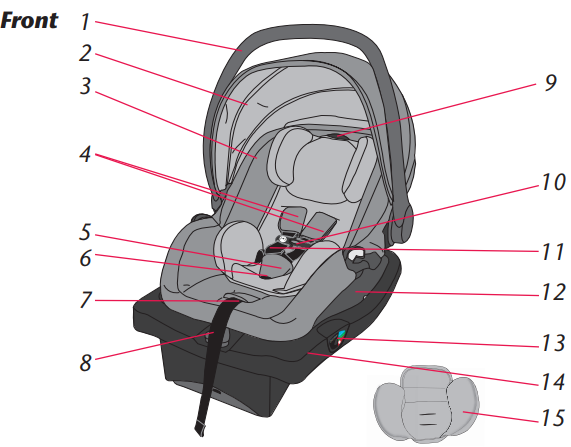
- Handle adjustment button
- Harness Straps
- Splitter Plate
- Carrier Release Handle
- Waist strap slots
- Waist strap
- Crotch Strap Anchor

* Not all features are available on all models. Styles may vary.
Using the Handle
To change handle positions, squeeze both Handle Releases and rotate the handle to the desired position until it locks into place.
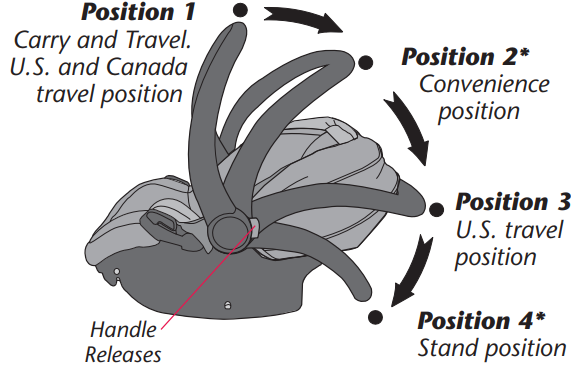
IMPORTANT: NEVER use Positions 2 or 4 when traveling in a vehicle. U.S. and Canadian models differ in acceptable handle positions for travel.
IMPORTANT: Always secure the child in the carrier.
Position 1 (Carry and Travel – U.S. and Canada)
This position is to be used to carry your child. For Canadian models, you MUST place the handle in this position when traveling in a vehicle.
Position 2 (Convenience)
NEVER use this position to carry your child in the carrier. NEVER use this position in the vehicle.
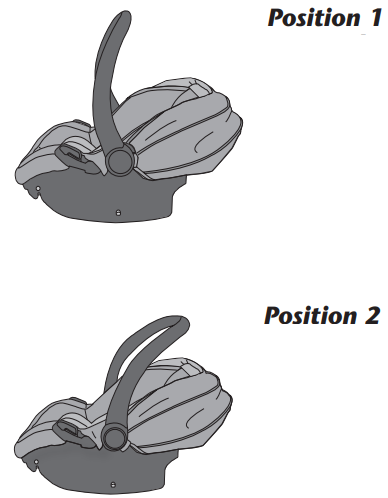
Position 3 (Travel – U.S.)
For U.S. models, you may place the handle in this position while traveling in a vehicle.
Position 4 (Stand)
Place the handle in this position when you set the carrier on the floor. NEVER use this position in a vehicle.
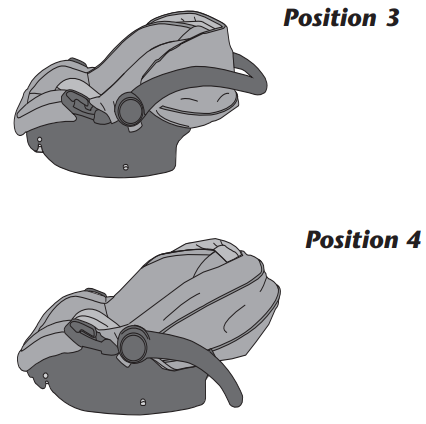
Description
The Evenflo Child Restraint System LiteMax DLX boasts a sleek and sturdy design that ensures maximum safety. The seat features a robust steel frame combined with energy-absorbing foam to protect your child in the event of an accident. The side impact protection adds an extra layer of security, while the comfortable padding ensures your child stays relaxed during long journeys. The seat is equipped with the innovative Infinite Slide Harness, allowing for effortless adjustments without rethreading the harness. Additionally, the TrueLock LATCH system simplifies installation, eliminating any guesswork and ensuring a secure fit every time.
Evenflo Child Restraint System LiteMax DLX Installation
Installing the Convenience Base with the Lower Anchor Connector
Before you begin, be sure the vehicle is on a level ground. Remove lower anchor connectors. Place base rear-facing on an approved vehicle seat location.
Note: NEVER allow white indicator line to appear in red zones.
The Leveling Foot that comes with your child restraint will be one of the following types (2a or 2b).
Note: NEVER allow white indicator line to appear in red zones.
Note: If you need to use the leveling foot, follow these steps.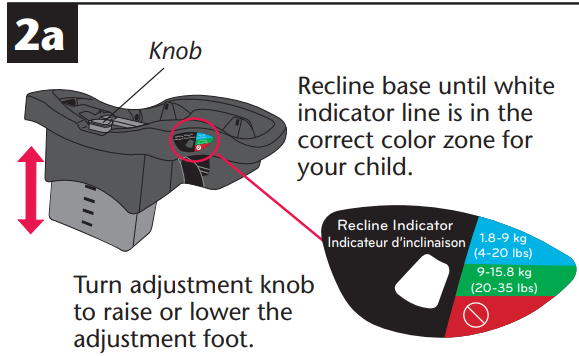
Turn the base over and rotate leveling foot up, as shown.
Push the leveling foot down until the locking tabs snap in place, as shown.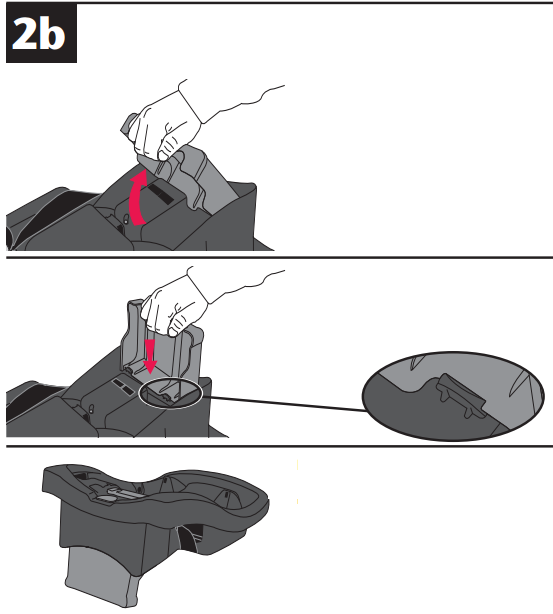
Base shown with leveling foot extended.
Note: To store the leveling foot, follow these steps.
Turn base over. While holding the base down with one hand, pull leveling foot up to disengage the locking tabs.
Rotate leveling foot to stored position.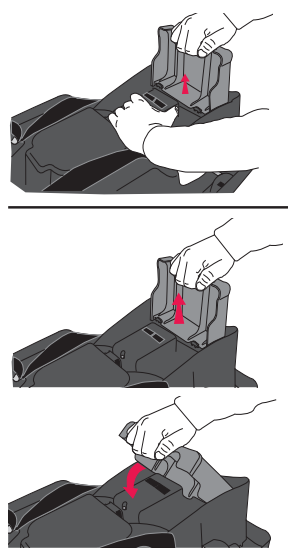
Base shown with leveling foot in stored position.

Turn the convenience base upside down. Depending on your model, the Lower Anchorage Storage will be under the base or on the sides of the base.
Remove both lower anchor hooks or clips.
Open One Step Lock-Off
Turn the convenience base right side up. Push down on Lock-Off while pushing back on Lock-Off Release Tab. Lift the Lock-Off up to reveal the belt path.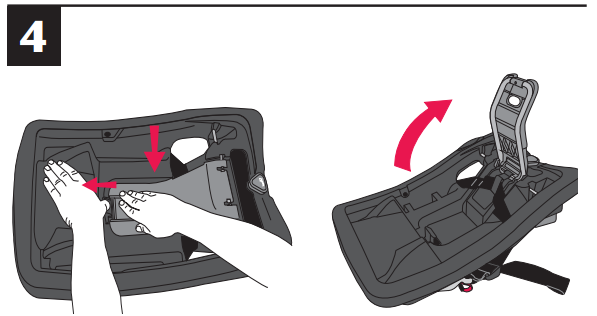
Know Your Lower Anchor Connector Assembly
The lower anchor connector assembly that comes with your child restraint will be one of the types below.
Refer to your vehicle owner’s manual to locate the lower anchor bars on your vehicle seat. Attach the right hook, or clip, to the right anchor bar and the left hook, or clip, to the left anchor bar. DOUBLE CHECK that the lower anchor connector hook, or clip, is fully engaged by pulling hard on the lower anchor connector strap.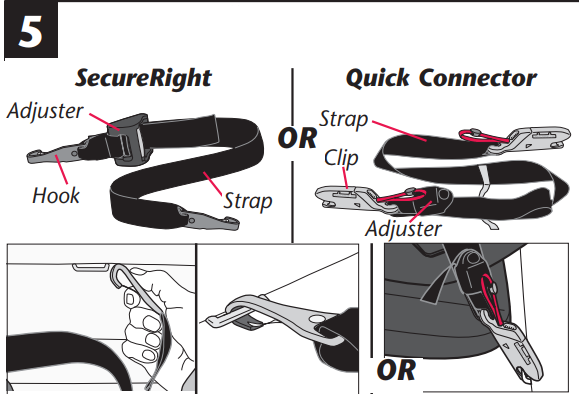
- Using your full weight, push the base into the vehicle seat, while pulling up on the strap to remove all slack from the lower anchor connector assembly.
Close One-Step Lock-Off
Place any excess lower anchor connector webbing to the side of the base. Do Not route it back under the Lock-off. Close the Lock-Off until it clicks into place.
Note: If unable to close the Lock-Off, loosen the lower anchor connector assembly, and try again.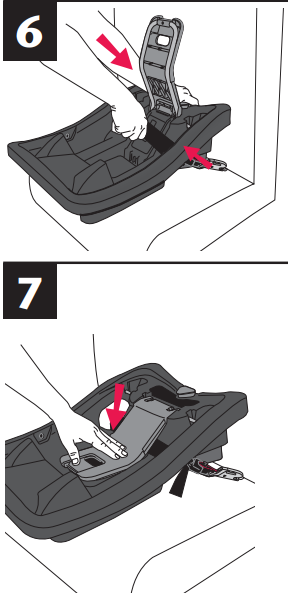
Make sure the lower anchor connector assembly harness is tight. Grab
the base at the areas, as shown. If you can move the base more than 25 mm (1 in.) side-to-side or front to back, the harness is not tight enough. You will need to try again, or find another location for your convenience base.
Place carrier on base, re-check level.
To remove lower anchor connector.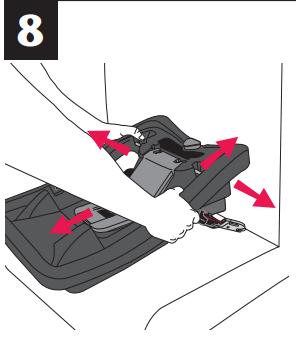
Installing the Convenience Base with the Vehicle Seat Belt
Before you begin, be sure the vehicle is on level ground. Store the lower anchor connectors
Using your full weight, push the base into the vehicle seat and check the level indicator.
Note: NEVER allow white indicator line to appear in red zones.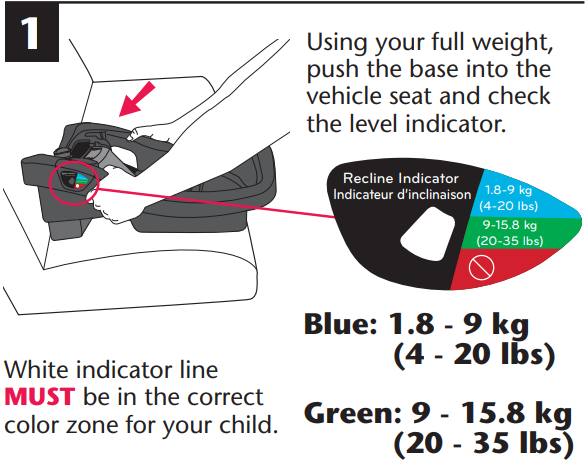
The Leveling Foot that comes with your child restraint will be one of the following types (2a or 2b).
Note: NEVER allow white indicator line to appear in red zones.
Note: If you need to use the leveling foot, follow these steps.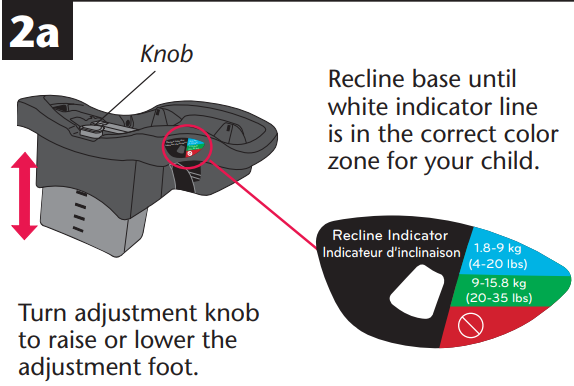
Turn base over and rotate leveling foot up, as shown.
Push leveling foot down until the locking tabs snap in place, as shown.
Base shown with leveling foot extended.
Note: To store the leveling foot, follow these steps.
Turn base over. While holding the base down with one hand, pull leveling foot up to disengage the locking tabs.
Rotate leveling foot to stored position.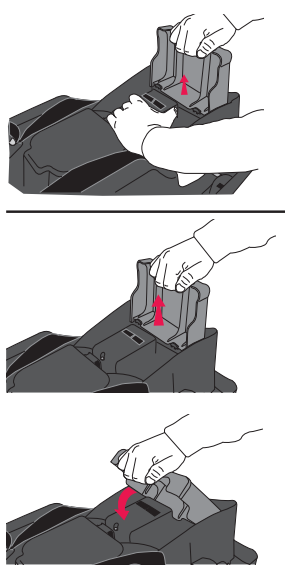
Base shown with leveling foot in stored position.
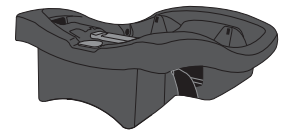
The Lock-Off provides a way to lock the child restraint without needing to lock your vehicle seat belt. (Refer to Vehicle‘s Owners Manual for vehicle seat belt use.)
Open One Step Lock-Off
Push down on Lock-Off while pushing back on Lock-Off Release Tab. Lift the Lock-Off up to reveal the belt path.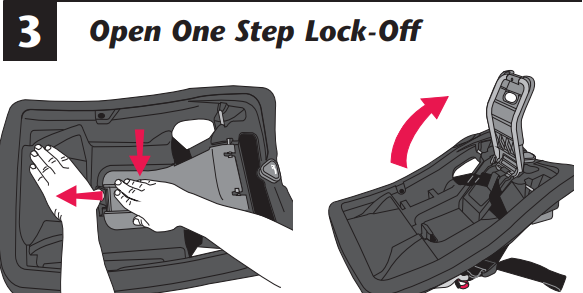
Secure the base to your vehicle seat by routing the lap/shoulder belt through the belt path openings on the sides of the base and through the vehicle belt clip. Fasten the buckle.
LAP / SHOULDER BELT
Pull the shoulder belt tightly to remove all slack from the lap portion of the belt, at the same time use your full weight to push down on the base.
Note: If seat belt Stop Button interferes with the Lock-Off, shift base to the left or right in order to prevent interference.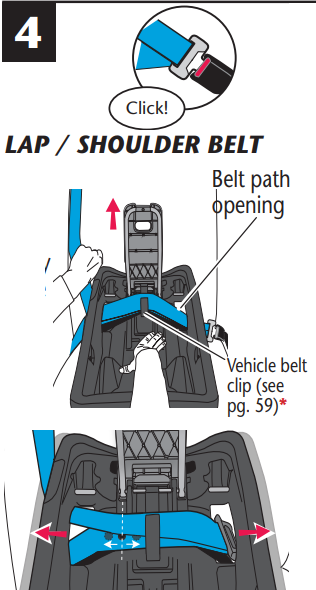
Secure the base to your vehicle seat by routing the lap belt through the belt path openings on the sides of the base and through the vehicle belt clip. Fasten the buckle.
LAP BELT
Pull the seat belt tightly to remove all slack from the lap portion of the belt, at the same time use your full weight to push down on the base.
IMPORTANT!For models without Vehicle Belt Clip, route lap/shoulder belt or lap belt as shown.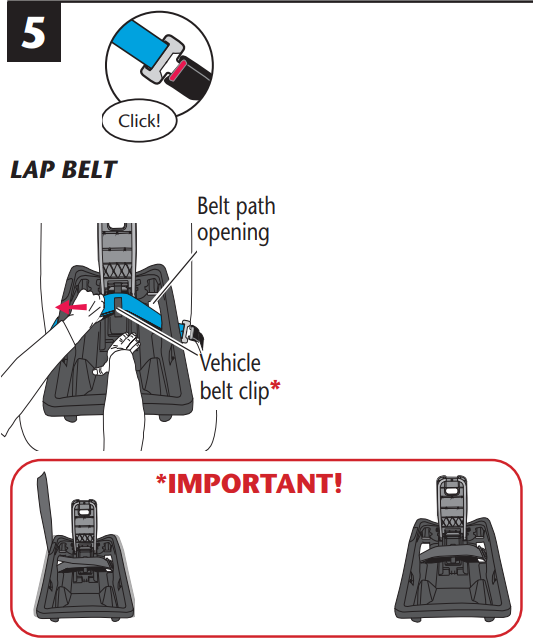
- Close the Lock-Off until it clicks into place.
WARNING!: DEATH or SERIOUS INJURY can occur,
Make sure the vehicle belt is tight. Grab the base at the areas, as shown. If you can move the base more than 25 mm (1 in.) side-to-side or front to back the vehicle belt is not tight enough. You will need to try again, or find another location for your convenience base.
Storing Your Instructions
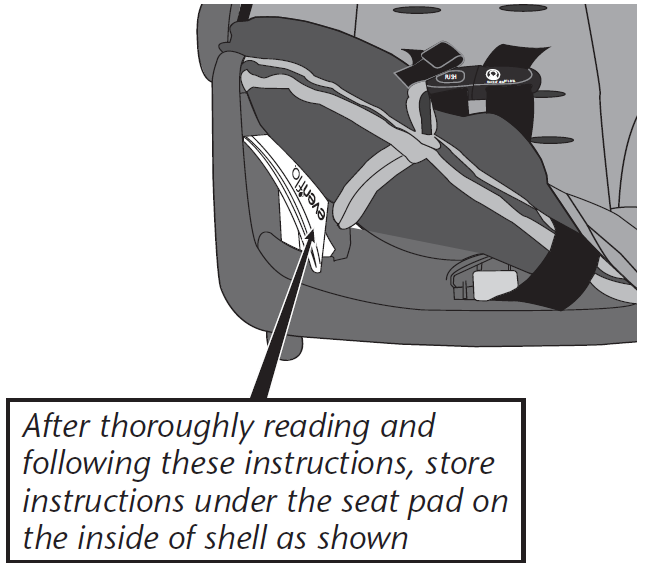
Setup Guide
To operate and assemble the Evenflo Child Restraint System LiteMax DLX:
- Rear-Facing Installation
Use the TrueLock LATCH system or seat belt to secure the seat.
Ensure the recline position is correct based on your vehicle’s specifications.
Adjust the harness to fit snugly around your child. - Forward-Facing Installation
Follow similar steps as rear-facing installation but adjust the recline position accordingly.
Make sure the harness is at or above your child's shoulders. - Booster Mode
Remove the backrest if necessary for high-back booster mode.
Use the vehicle’s seat belt to secure your child.
Care and Cleaning
- DO NOT lubricate or immerse in water the LATCH connectors, the buckle, or any other part of this child restraint, unless rinsing is permitted, as stated on the back of the buckle for your restraint.
- Plastic and metal parts may be wiped clean with mild soap and water and dried with a soft cloth. Do not use abrasive cleaners or solvents.
- Take care not to damage any labels.
- The harness can be wiped clean with mild soap and water. Allow harness to air dry.
- Machine wash the seat pad separately in cold water, delicate cycle. Tumble dry 10 to 15 minutes on low heat.
- NEVER use child restraint without the seat pad.
- To protect the child restraint from damage caused by weather, rodents, and other elements common to garages, the outdoors, and other storage locations, remove the seat pad and thoroughly clean the restraint and pad prior to storage. Take care to clean in the areas where crumbs and other debristend to accumulate.
TIP: To help protect the vehicle upholstery, place a towel beneath and behind the child restraint.
WARNING: To reduce the risk of serious injury or death, read this owner's manual prior to installing and using this child restraint.
- More children are killed every year as passengers in car crashes than by any other type of injury.
- To reduce the risk of SERIOUS INJURY or DEATH, read this owner’s manual and your vehicle owner’s manual before installing and using this child restraint.
- Using a child restraint makes a big difference. By properly using this child restraint and following these instructions (and the instructions that accompany your vehicle), you will greatly reduce the risk of serious injury or death to your child from a crash.
- Do not be misled by the commonly used term “safety seat”; no restraint system can prevent all injuries in all crashes. Many properly restrained adults and children are injured in motor vehicle crashes, including relatively minor crashes.
- A properly used child restraint is the best way to minimize injuries to your child and to increase the chances for your child’s survival in most crashes.
Child Requirements
Warning: Failure to follow these Child Requirements could result in serious injury or death.
This child restraint is designed for use by children in rear-facing orientation only. To use this child restraint properly, children MUST meet the size and age requirements below. In addition, Evenflo recommends consulting with your child’s physician before allowing your child to transition from a rear-facing to forward-facing child restraint.
The American Academy of Pediatrics (AAP) recommends keeping children rear-facing until 2 years old or until they reach the maximum height or weight for their child restraint in rear-facing orientation. Additionally, some states’ laws require children to be rear-facing until age 2. Accordingly, you will see this guidance reflected in the Child Requirements. Please review any applicable local, state or provincial laws related to child passenger safety before installing and using this child restraint.
Rear-facing Use
- 1.8 to 15.8 kg (4 to 35 lbs)
- 43 to 81 cm (17 to 32 in.) and top of child’s head is at least 25 mm (1 in.) below the top of the child restraint seat back.

IMPORTANT: Once your child exceeds any of the size requirements above, they MUST discontinue use of this child restraint.
PREMATURE INFANT USE
Before using this child restraint for preterm or low birth weight infants, ensure the Child Requirements are met and follow the guidelines in this section.
According to the U.S. National Highway Traffic Safety Administration, a properly installed child restraint reduces the risk of death by over 70% for infants involved in crashes. Federal Motor Vehicle Safety Standard (FMVSS) 213 establishes design and dynamic performance requirements for child restraint systems. However, the standard has no minimum weight limit and does not address the special medical needs of preterm or low birth weight infants. To ensure that preterm and low birth weight infants are transported safely, the guidelines published by the American Academy of Pediatrics (AAP) in Pediatrics 2009;123:1424–1429 must be followed.
All children should ride rear-facing in the vehicle as long as possible. Preterm and low birth weight infants are at additional risk of breathing difficulties and heart problems when placed in a child restraint. Evenflo requires that the evaluation recommended by the AAP be conducted for all infants born earlier than 37 weeks and all newborn infants who weigh less than 5 lb at birth before their first car trip to check for breathing difficulties or heart rate problems when traveling in a rear-facing child restraint.
The AAP recommends that appropriate hospital staff observe your infant in the child restraint for a period of 90 to 120 minutes or the duration of travel, whichever is longer. This period of observation must be performed with the infant properly positioned as described in these instructions and with the child restraint placed at an angle that is approved for use in the vehicle. The hospital staff will check for any breathing difficulties or heart rate problems. Your child’s pediatrician will let you know if there are any special considerations for travel. The number of trips and the duration of time the infant is seated in the child restraint should be minimized. A caregiver should ride in the back seat to monitor the infant during travel. You can learn more about the AAP’s recommendations for observation of newborns and the guidelines for safe transportation of preterm and low birth weight infants, as well as other resources for parents and medical professionals, at https://www.healthychildren.org/english/safety-prevention/on-the-go/Pages/default.aspx
WARNING! DEATH or SERIOUS INJURY can occur,
General Warnings
- Child restraints should be used only for travel. Potential adverse health effects from excessive use of infant child restraints have been documented. You should limit the time spent each day in a child restraint as much as possible. You must NEVER use your child restraint as a sleeping environment in the home. NEVER leave your infant unattended in a child restraint in or out of the vehicle.
- Failure to follow these installation instructions and the instructions and warnings on the product can result in your child striking the vehicle’s interior during a sudden stop or crash. Serious injury or death may result. These instructions and the instructions in your vehicle owner’s manual must be followed carefully. If there is a conflict between the two, the vehicle owner’s manual regarding child restraint installation must be followed.
- This child restraint MUST ALWAYS face the rear of the vehicle. Serious injury or death can occur if used forward-facing.
- NEVER leave child unattended.
- DO NOT use child restraint if it is damaged, broken, or missing parts.
- DO NOT use this restraint if it has been involved in a crash. It must be replaced.
- DO NOT attach additional padding, toys or other devices not made by Evenflo, or described in these instructions, to the child restraint. Items not tested with the child restraint could injure the child.
- Be sure that the handle is firmly locked in Position 1 (Carry) before lifting the child restraint.
- This child restraint must be securely belted to the vehicle at all times, even when unoccupied. An unsecured child restraint may injure someone if a crash occurs.
- DO NOT place rear-facing child seat on front seat with an air bag. DEATH OR SERIOUS INJURY can occur. The back seat is the safest place for children 12 and under.
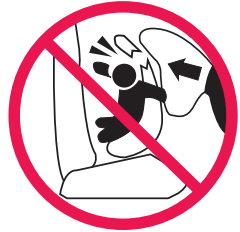
Air Bag Warnings
To help prevent serious injury or death:
- DO NOT use this restraint in the front seat of a vehicle equipped with an air bag. Interaction between a rear-facing restraint and air bags may cause serious injury or death. If your vehicle has an air bag, refer to the vehicle owner’s manual for child restraint installation. If the rear seat of your vehicle is equipped with side air bags, refer to the following information for proper usage.
- Vehicles built prior to the 2002 model year:
DO NOT use this restraint in a vehicle seating position equipped with a side air bag unless authorized by the vehicle manufacturer. - Model year 2002 and newer vehicles:
Refer to your vehicle owner’s manual before placing this restraint in a seating position equipped with a side air bag.
- Vehicles built prior to the 2002 model year:
- DO NOT place any objects between the restraint and the side air bag, as an expanding air bag may cause the items to strike your child.
The forward facing back seat is the safest place for children 12 and under.

Troubleshooting
- Common Problems:
- Incorrect Installation: Ensure all parts are securely fastened and in the correct position.
- Harness Issues: Check if the harness needs rethreading or if it’s too tight/loose.
- Comfort Concerns: Adjust padding or recline positions for better comfort.
- Solutions:
- Refer to the manual for detailed installation instructions.
- Regularly inspect the harness for wear and tear.
- Contact customer support if issues persist. -
Instructions & Warnings
- Always follow local and federal safety regulations.
- Never leave your child unattended in the car seat.
- Regularly clean and maintain the seat according to manufacturer guidelines.
Limited Warranty
For a period of 90 days from the original purchase of this Product, Evenflo warrants to the original end user (“Purchaser”) this Product (including any accessories) against defects in material or workmanship.
Pros & Cons
Pros
- Versatile: Can be used in multiple modes from infancy to booster age.
- Easy Installation: TrueLock LATCH system simplifies setup.
- Safety Features: Robust steel frame and energy-absorbing foam provide excellent protection.
- Comfortable: Padded seats ensure long trip comfort.
- Adjustable Harness: Infinite Slide Harness allows for effortless adjustments.
Cons
- Bulkier Design: This may take up more space compared to other car seats.
- Higher Price Point: Though worth it, some may find it more expensive than other options.
- Complexity: Multiple modes can make initial setup confusing for some users.
Customer Reviews
Parents have praised the Evenflo Child Restraint System LiteMax DLX for its ease of use and robust safety features. However, some have noted that the bulkier design can be challenging when fitting multiple car seats in a row. Despite this minor drawback, overall satisfaction is high due to its versatility and comfort.
Most common complaints include difficulty with initial setup due to the complexity of its multi-mode design and occasional issues with harness adjustments.
Faqs
What is the weight range for the Evenflo Child Restraint System LiteMax DLX?
How do I install the Evenflo Child Restraint System LiteMax DLX in rear-facing mode?
What are some common issues with harness adjustments?
Can I use this car seat as a high-back booster?
What safety features does this car seat offer?
Is this car seat compatible with all vehicles?
How long does the warranty last?
Can I purchase additional parts or accessories?
Leave a Comment
